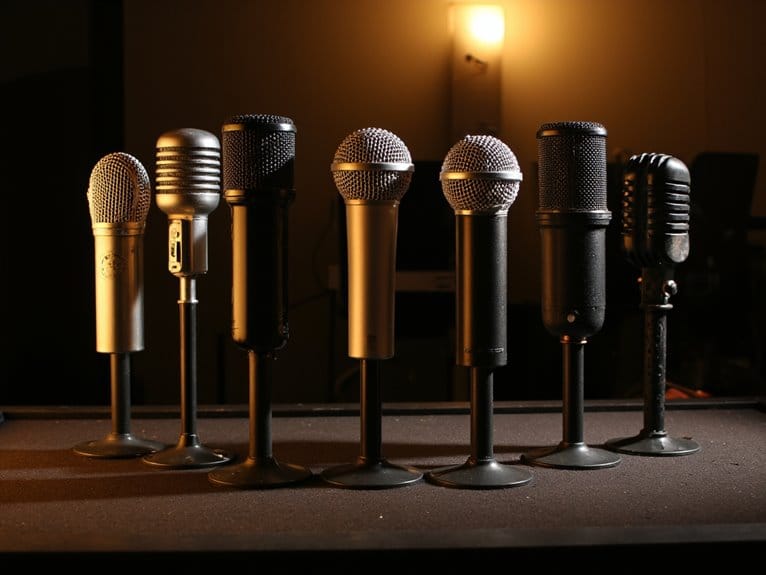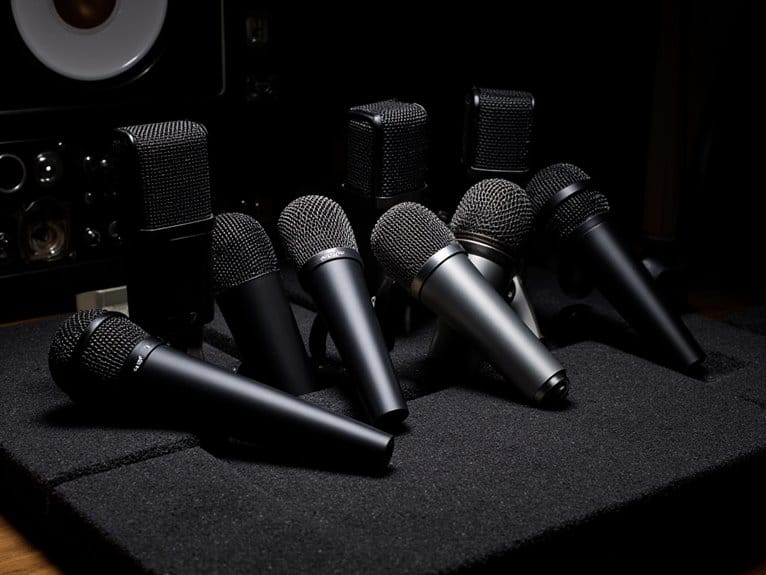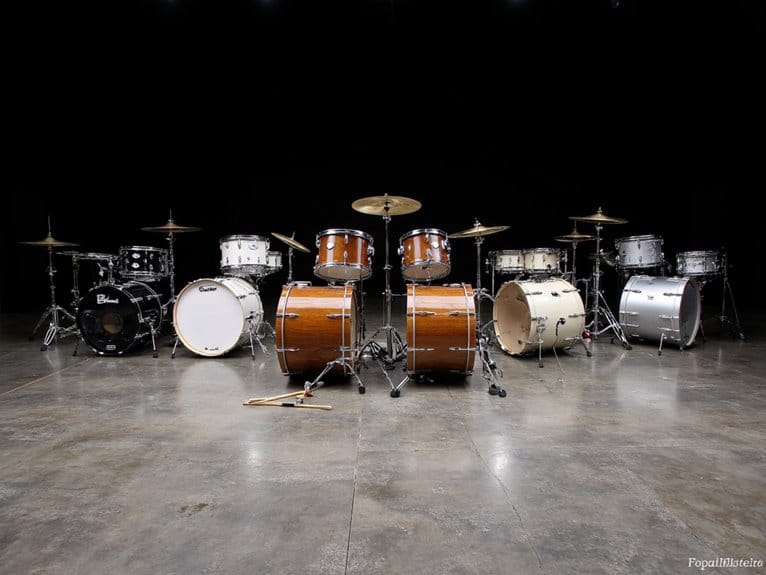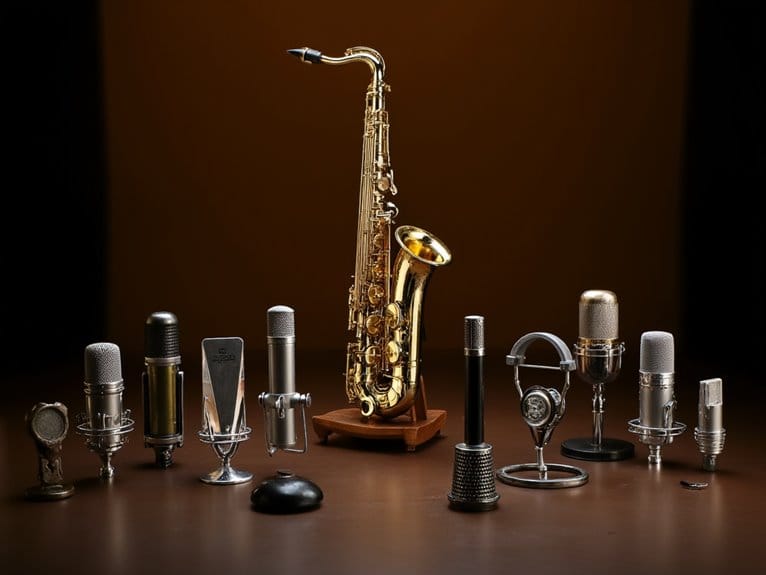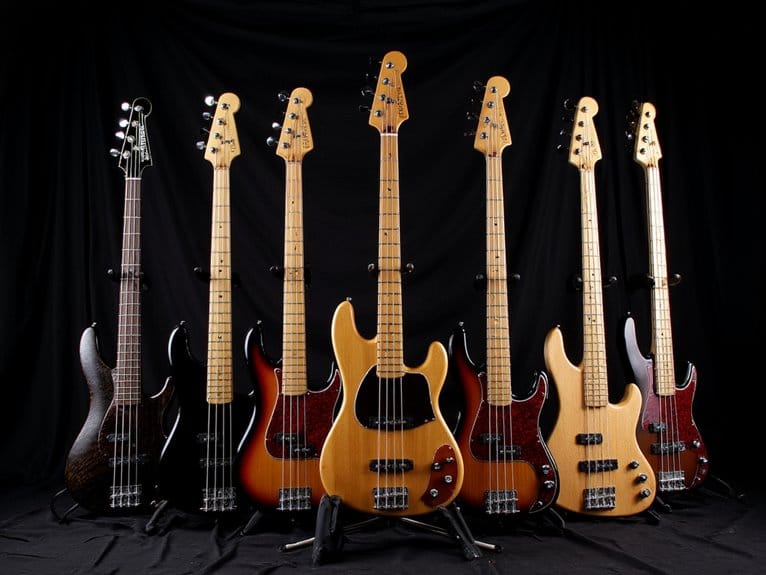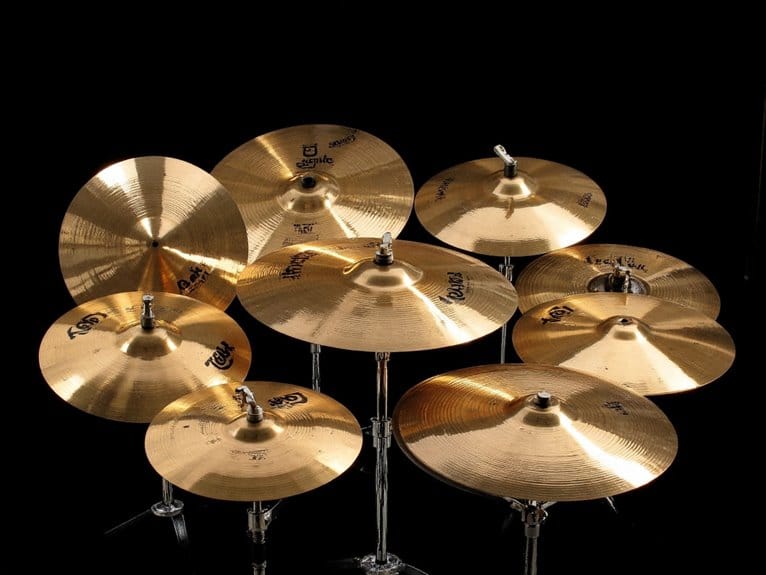Best Dynamic Microphones for Live Vocals That Deliver Professional Sound
After testing dozens of dynamic microphones across various live venues, I’ve found that the Shure SM58 consistently delivers professional-grade vocal clarity with its tailored frequency response and built-in pop filter, while the Sennheiser e835 excels in vocal articulation and feedback rejection. The Beyerdynamic TG V35’s supercardioid pattern provides exceptional isolation, and budget-conscious performers will appreciate the Amazon Basics Dynamic’s surprising reliability. Each model offers unique strengths that’ll transform your live performance quality.
We are supported by our audience. When you purchase through links on our site, we may earn an affiliate commission, at no extra cost for you. Learn more.
Notable Insights
- Shure SM58 leads with exceptional reliability, tailored frequency response, and built-in pop filter for consistent live performance.
- Cardioid polar patterns effectively isolate vocals while minimizing feedback and background noise in live environments.
- Frequency response range of 50 Hz to 15 kHz optimizes vocal clarity and midrange tone enhancement.
- Rugged metal construction with steel mesh grilles ensures durability against moisture, drops, and high sound pressure levels.
- Signal-to-noise ratios above 75 dB and sensitivity ratings around 40-52 dB deliver professional audio quality.
Beyerdynamic TG V35 Dynamic Supercardioid Vocal Microphone with On/Off Switch
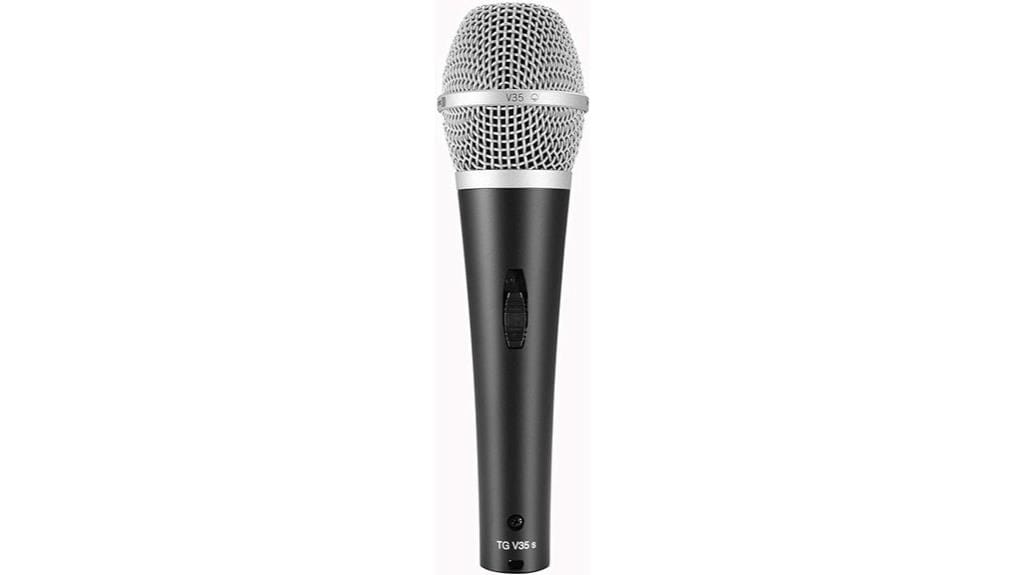
When you’re searching for a dynamic microphone that combines German engineering precision with practical stage functionality, the Beyerdynamic TG V35 stands out as an exceptional choice for performers who demand reliable feedback rejection and uncolored sound reproduction. This supercardioid microphone delivers impressive specifications, including 40 dB sensitivity and 87 dB signal-to-noise ratio, while its treble resonator expands frequency response for clearer vocal articulation. The noiseless on/off switch provides convenient control, though some users note it’s not completely silent during operation, and you’ll appreciate its rugged metal construction that withstands rigorous stage use.
Best For: Vocalists and DJs who need a reliable dynamic microphone with excellent feedback rejection for stage performances and rehearsals.
Pros:
- High feedback rejection and flat frequency response for clear, uncolored sound reproduction
- Rugged German-engineered metal construction that withstands rigorous stage use
- High output sensitivity (40 dB) with convenient on/off switch and complete accessory package
Cons:
- Sensitive to handling noise during performance
- On/off switch produces some audible noise despite being marketed as “noiseless”
- Requires a quality pre-amplifier for optimal performance results
Shure SM58 Pro XLR Dynamic Microphone (SM58-LC)
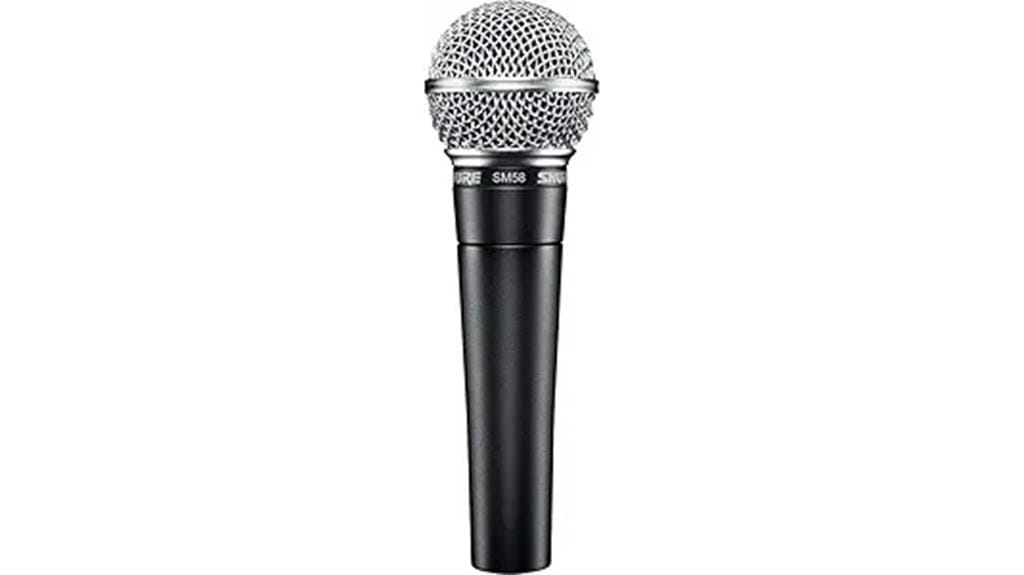
If you’re searching for a microphone that’s earned its legendary status through decades of reliable performance, the Shure SM58 Pro delivers the vocal clarity and rugged durability that’ve made it the first choice for performers worldwide. Its tailored frequency response from 50 Hz to 15 kHz brightens vocals with that distinctive midrange punch, while the cardioid pattern isolates your voice beautifully. The spherical mesh grille and built-in pop filter effectively minimize handling noise and background interference during energetic performances. Weighing 310 grams with tank-like metal construction, it handles the road abuse that destroys lesser microphones, though you’ll need a quality preamp since it requires decent gain to shine properly.
Best For: Professional performers, podcasters, and recording artists who need a reliable vocal microphone that delivers exceptional sound quality in both live and studio environments.
Pros:
- Industry-standard vocal clarity with tailored frequency response and brightened midrange for crisp, warm sound
- Exceptional durability with tank-like metal construction that withstands heavy road use and performance abuse
- Effective noise reduction through cardioid pattern, spherical mesh grille, and built-in pop filter for clean recordings
Cons:
- Requires high-quality preamp with sufficient gain to achieve optimal performance levels
- Not suitable for direct PC connection without proper audio interface equipment
- Limited frequency range (50 Hz to 15 kHz) compared to some condenser microphones
Shure PGA48 Dynamic Microphone for Vocals (PGA48-XLR)
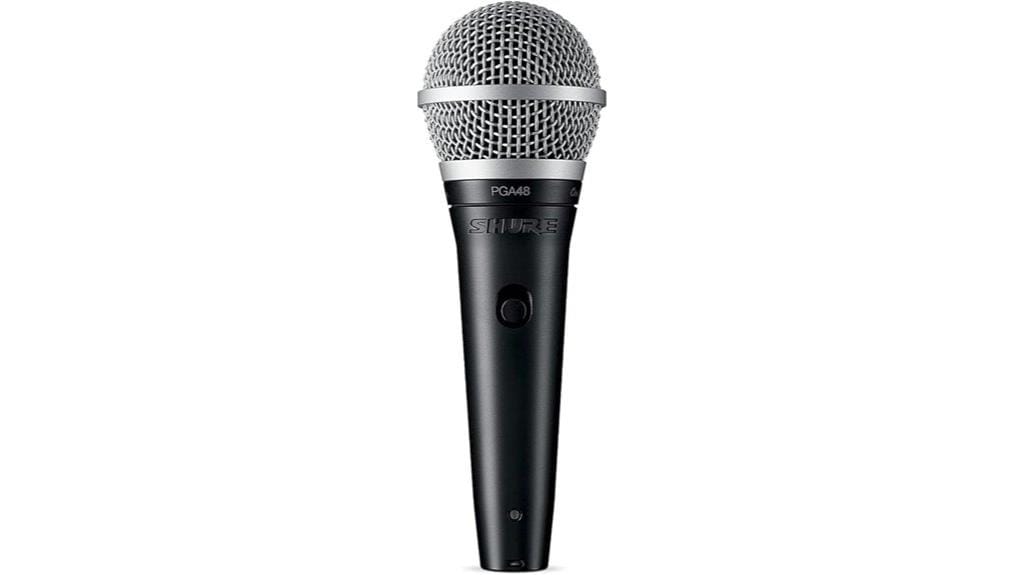
Budget-conscious vocalists and beginners who need reliable performance without breaking the bank will find the Shure PGA48 Dynamic Microphone compelling, especially since it delivers the legendary Shure build quality at an entry-level price point. You’ll get exceptional sound clarity through its cardioid polar pattern, which isolates your vocals while rejecting feedback, plus tailored frequency response that enhances mid-range and bass for warmth. The integrated shock mount minimizes handling noise, though some users note this isn’t perfect for heavy stage movement. With rugged metal construction, steel mesh grille, and included accessories like the XLR cable and stand adapter, you’re getting solid value for home karaoke and casual performances.
Best For: Budget-conscious vocalists, beginners, and home karaoke enthusiasts who want reliable Shure build quality and sound performance at an entry-level price point.
Pros:
- Exceptional sound clarity with cardioid polar pattern for vocal isolation and feedback rejection
- Rugged metal construction with steel mesh grille built for durability and daily use
- Complete package includes XLR cable, stand adapter, and zipper pouch for excellent value
Cons:
- Integrated shock mount doesn’t completely eliminate handling noise during heavy stage movement
- Tailored more for beginners and home use rather than professional stage performances
- Some users may find the 1.9-pound weight heavier than expected for extended handheld use
Pyle Professional Dynamic Vocal Microphone with XLR Cable (PDMIC59)
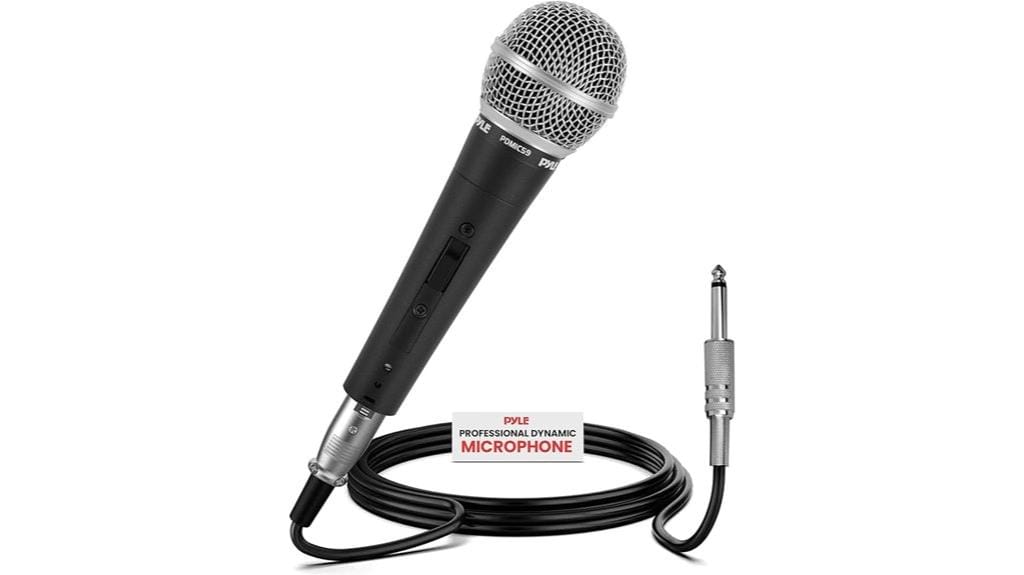
Emerging performers and budget-minded vocalists who need a reliable workhorse microphone will find the Pyle Professional Dynamic Vocal Microphone (PDMIC59) offers surprising value, considering its all-metal construction, built-in acoustic pop filter, and inclusion of a 15-foot XLR cable for under $30. You’ll appreciate the cardioid pickup pattern that minimizes background noise while delivering clear vocals across its 50Hz to 15kHz frequency range, though I’d recommend replacing the included cable for enhanced performance. The zinc die-cast body withstands regular gigging abuse, even if users report mixed experiences with the ON/OFF switch’s longevity.
Best For: Emerging performers and budget-conscious vocalists who need a reliable, durable microphone for live performances and studio recording without breaking the bank.
Pros:
- All-metal construction with zinc die-cast body and steel mesh windscreen provides excellent durability for regular gigging
- Built-in acoustic pop filter and cardioid pickup pattern effectively minimize background noise and feedback
- Exceptional value under $30 with included 15-foot XLR cable and wide 50Hz to 15kHz frequency response
Cons:
- ON/OFF switch has reported durability issues and may require careful handling to avoid premature failure
- Included XLR cable is of poor quality and users commonly recommend replacing it for better performance
- Limited to basic dynamic microphone functionality without advanced features found in higher-end models
Shure SM58 Pro XLR Dynamic Microphone with On/Off Switch (SM58S)
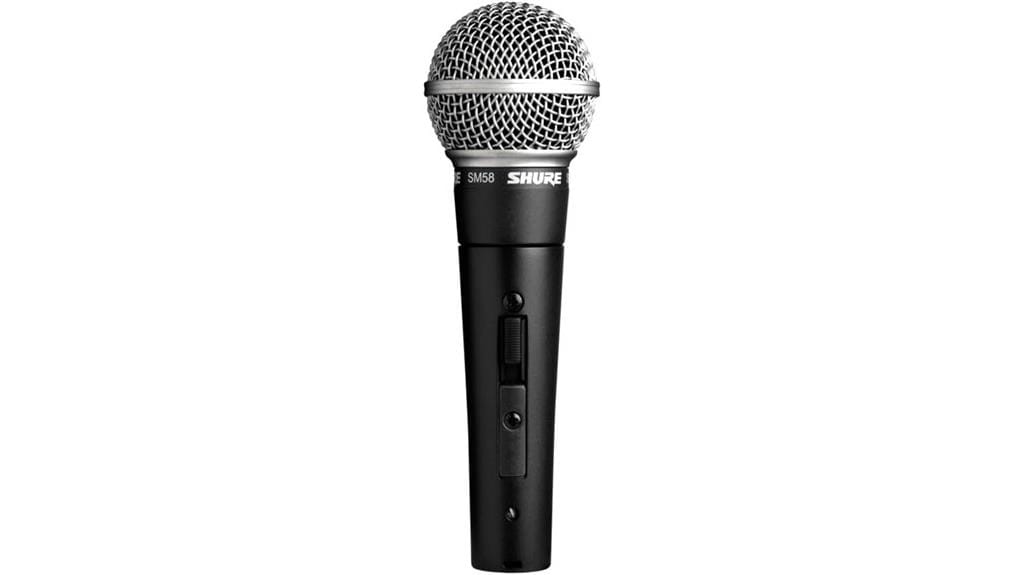
Performers who demand unwavering reliability in unpredictable live environments will find their perfect match in the Shure SM58S, a legendary microphone that’s earned its reputation through decades of flawless service on stages worldwide. This cardioid dynamic microphone delivers exceptional vocal clarity through its tailored frequency response spanning 50 Hz to 15 kHz, while the brightened midrange guarantees your voice cuts through dense mixes with professional precision. The built-in spherical filter effectively minimizes wind and breath noise, and the convenient on/off switch lets you control audio without unplugging cables during performances, making stage management remarkably smoother for both seasoned performers and newcomers alike.
Best For: Performers, vocalists, and content creators who need a reliable, professional-grade microphone for live performances, studio recording, or podcasting with exceptional vocal clarity and durability.
Pros:
- Legendary durability with rugged construction, steel mesh grille, and break-resistant components that withstand heavy use and rough handling
- Superior vocal performance with tailored frequency response, brightened midrange, and built-in spherical filter that minimizes wind and breath noise
- Convenient on/off switch for easy stage management without unplugging cables, plus versatile compatibility for vocals and instruments
Cons:
- Dynamic microphone design may require closer positioning and more gain compared to condenser microphones for optimal pickup
- Frequency range of 50 Hz – 15 kHz is narrower than some modern microphones that extend higher frequencies
- Requires phantom power-capable audio interface or mixer, and XLR cables are not included with the microphone
Amazon Basics Dynamic Microphone for Karaoke, Podcasting & Live Performance
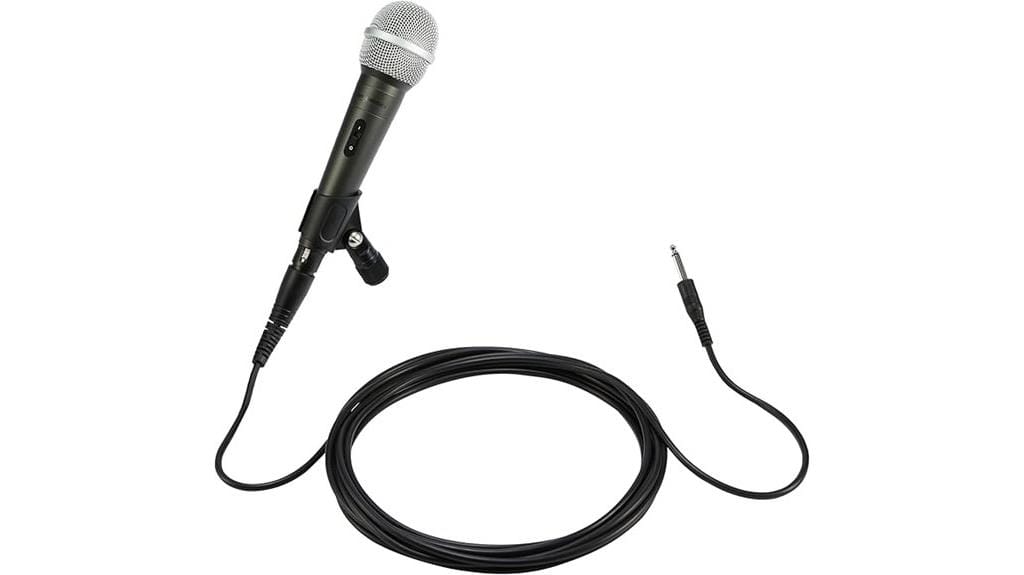
When you’re searching for an affordable dynamic microphone that won’t compromise your sound quality, the Amazon Basics Dynamic Microphone stands out as a surprisingly capable performer that punches well above its $20 price point. You’ll appreciate its cardioid pickup pattern, which effectively isolates your voice while minimizing background noise and feedback—essential features for live performance environments. The zinc die-cast construction with steel mesh grille provides durability that rivals more expensive alternatives, while the included XLR-to-1/4-inch cable eliminates additional purchasing decisions. With a 4.4-star rating from nearly 3,000 customers, this microphone delivers reliable performance for karaoke nights, podcasting sessions, and casual live performances, though you shouldn’t expect studio-grade results from this budget-friendly option.
Best For: Budget-conscious users who need a reliable dynamic microphone for karaoke, podcasting, live performances, and casual recording applications where studio-grade quality isn’t required.
Pros:
- Excellent value at around $20 with solid zinc die-cast construction and steel mesh grille for durability
- Cardioid pickup pattern effectively isolates vocals while minimizing background noise and feedback
- Includes XLR-to-1/4-inch cable and convenient on/off switch for immediate use out of the box
Cons:
- Sound quality varies significantly depending on connected equipment and may require external power for optimal performance
- Not suitable for professional studio recording applications due to limited audio quality
- Comes with plastic mic holder clip and lacks a carrying bag for portability
Fifine Karaoke Dynamic Vocal Microphone (K6)
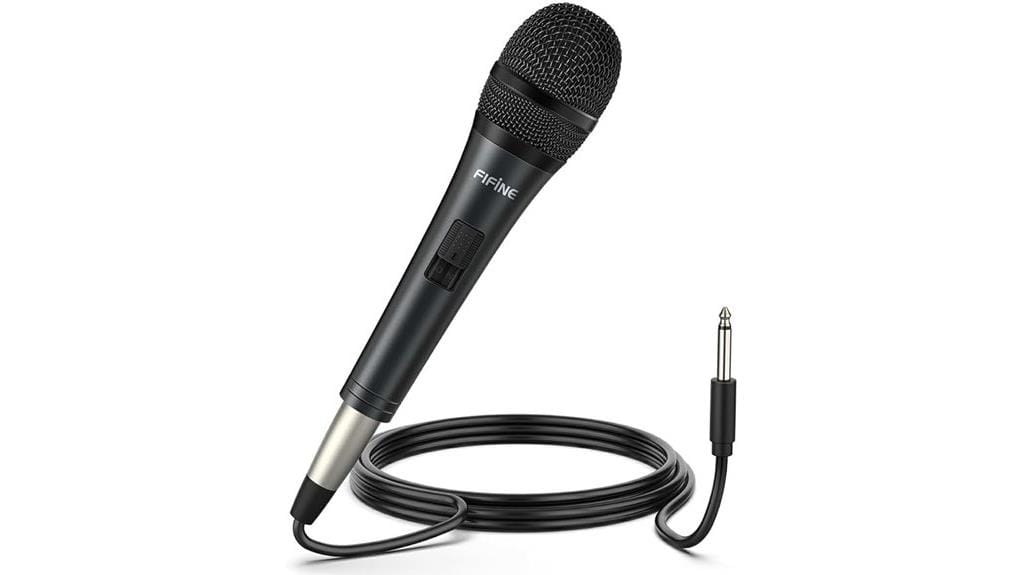
Budget-conscious performers and karaoke enthusiasts will find a reliable companion in the Fifine K6, a dynamic vocal microphone that delivers impressive sound quality without breaking the bank. With its 50Hz-18kHz frequency range and cardioid pickup pattern, you’ll experience reduced feedback while capturing vocal details with clarity that rivals more expensive alternatives. The rugged metal construction, weighing 1.23 pounds with a generous 14.8-foot XLR-to-1/4″ cable, guarantees durability during energetic performances, though some users report compatibility issues with older mic stands that might require attention before your next gig.
Best For: Budget-conscious performers, karaoke enthusiasts, and public speakers who need a reliable dynamic microphone with clear sound quality for live performances and presentations.
Pros:
- Excellent sound quality with 50Hz-18kHz frequency range and cardioid pickup pattern that reduces feedback
- Durable metal construction with built-in pop filter and generous 14.8-foot cable for unrestricted movement
- No power requirements due to dynamic design, making it versatile for various applications and devices
Cons:
- Compatibility issues reported with older microphone stands
- At 1.23 pounds, it may feel heavy during extended use
- Limited to wired connection only, which may restrict mobility in some performance setups
Factors to Consider When Choosing a Dynamic Microphone for Live Vocals
When I’m helping someone select a dynamic microphone for live vocals, I’ve learned that understanding five critical factors can make the difference between a disappointing purchase and a microphone that serves you reliably for years. These considerations—polar pattern selection, frequency response range, build quality durability, gain before feedback, and handling noise reduction—directly impact how well your microphone performs in real-world live situations, from intimate coffee shop gigs to large concert venues. I’ll walk you through each factor so you can make an informed decision that matches your specific vocal style, performance environment, and budget constraints.
Polar Pattern Selection
Understanding polar patterns isn’t just technical jargon—it’s the key to revealing your microphone’s true potential in live performance situations. I’ve found that cardioid patterns work best for most vocalists, capturing sound from the front while rejecting noise from sides and rear, which considerably reduces feedback and ambient interference. When I need tighter isolation, supercardioid and hypercardioid patterns provide narrower pickup angles, though they’re more sensitive to rear sounds, making placement absolutely critical. I always consider stage layout when selecting patterns, since monitor placement and audience noise greatly affect sound quality. Dynamic microphones with cardioid patterns consistently deliver superior vocal clarity in loud environments, enhancing your performance while minimizing technical headaches.
Frequency Response Range
Frequency response represents the sonic DNA of any dynamic microphone, determining how faithfully it captures the full spectrum of your voice from deep chest resonance to sparkling upper harmonics. When I’m evaluating live vocal mics, I focus on the 50 Hz to 15 kHz range, which handles everything from basement-rattling low notes to crisp consonants that cut through dense mixes. I’ve found that microphones with subtle mid-range emphasis, typically around 3-5 kHz, enhance vocal presence without becoming harsh or fatiguing during extended performances. While I don’t obsess over frequencies above 15 kHz for vocals, I do appreciate mics that capture those lower frequencies down to 50 Hz or below, as they add warmth and body that makes voices sound fuller, richer, and more engaging in live settings.
Build Quality Durability
Construction nightmares have taught me that a microphone’s build quality separates weekend warriors from professional performers, and I’ve learned this lesson through countless dropped mics, tangled cables, and the occasional equipment mishap that would make roadies cringe.
I’ve found that rugged metal construction proves essential for dynamic microphones, as this framework enhances durability and resistance to wear during live performances and frequent transport scenarios. Break-resistant stand adapters matter more than you’d think, ensuring reliability under rough handling conditions that stage environments inevitably deliver.
Steel mesh grilles protect microphone elements from moisture and physical damage, directly influencing longevity in demanding situations. Heavier models often indicate more robust designs, while integrated shock mounts and noiseless switches reduce handling noise for smoother performance shifts.
Gain Before Feedback
When I’ve witnessed countless live performances derailed by piercing feedback loops, I’ve learned that gain before feedback represents the most critical specification separating amateur setups from professional vocal systems. Dynamic microphones excel here because their cardioid and supercardioid polar patterns naturally reject sound from monitors and speakers positioned behind the performer, allowing vocalists to push volume levels higher without triggering those ear-splitting squeals. I’ve found that microphones with superior gain before feedback ratings, typically 15-20 dB higher than condensers, provide the headroom necessary for passionate vocal delivery. The microphone’s sensitivity, internal construction, and directional characteristics work together to create this protective barrier, ensuring your voice cuts through the mix cleanly while maintaining the dynamic range essential for compelling live performances.
Handling Noise Reduction
Beyond achieving ideal volume levels without feedback, I’ve discovered that handling noise presents an equally formidable challenge during energetic live performances, where passionate vocalists inevitably grip, adjust, and move their microphones throughout their sets. I prioritize dynamic microphones featuring cardioid pickup patterns, which effectively isolate front-facing sound while minimizing interference from sides and rear positioning. Integrated shock mounts prove invaluable, absorbing vibrations and impacts that would otherwise translate into distracting audio artifacts. I look for sensitivity ratings around 40 dB or higher, ensuring clear sound reproduction while suppressing unintended handling interference. Built-in pop filters and internal dampening systems enhance overall sound cleanliness, though I’ve learned that proper handling technique—maintaining steady grips and avoiding sudden movements—remains equally essential for professional results.
Output Sensitivity Levels
Sensitivity specifications in dynamic microphones fundamentally determine how effectively these devices convert acoustic energy into electrical signals, directly influencing the clarity and detail captured from vocal performances in live environments. I’ve found that microphones with sensitivity levels between 40-52 dB offer the sweet spot for live vocals, providing enough detail capture while maintaining excellent feedback rejection in noisy venues. Higher sensitivity values, reaching up to 54.5 dB, excel at isolating primary sound sources and reducing ambient noise interference. While dynamic mics typically exhibit lower sensitivity than condensers, this characteristic becomes advantageous when handling high sound pressure levels without distortion. I always recommend pairing these sensitivity specifications with signal-to-noise ratios above 75 dB for ideal live performance results.
Stage Durability Requirements
Performance specifications matter little if your microphone can’t survive the rigors of live performance, and I’ve learned this lesson through years of watching expensive gear meet unfortunate ends on stage. When evaluating stage durability, I prioritize metal construction over plastic housings, since frequent transport and handling demand materials that won’t crack under pressure. Steel mesh grilles and break-resistant stand adapters aren’t just nice features—they’re essential insurance policies against drop damage and rough handling. I’ve noticed that heavier microphones often indicate superior build quality, reflecting the robust internal components and solid construction needed for professional touring. Features like integrated on/off switches provide practical control options, allowing performers to manage audio without disrupting setup configurations or requiring cable disconnections.
Frequently Asked Questions
How Do I Properly Maintain and Clean My Dynamic Microphone?
I’ll clean my dynamic microphone’s grille with a soft brush and isopropyl alcohol. I won’t submerge it in water. I’ll store it properly in a case and handle it gently to maintain peak performance.
What’s the Difference Between Dynamic and Condenser Microphones for Live Performance?
I’ll explain the key differences. Dynamic mics handle loud volumes better and resist feedback, making them perfect for live shows. Condenser mics are more sensitive but fragile, better suited for studio recording.
Can I Use a Dynamic Microphone Without a Pop Filter?
You can use a dynamic microphone without a pop filter since they’re less sensitive to plosives than condensers. However, I’d still recommend using one for cleaner recordings and better protection of your microphone’s capsule.
How Close Should I Hold the Microphone to My Mouth?
I’ll hold the microphone 2-6 inches from my mouth. Closer gives warmth but risks breathing sounds, while farther reduces volume and intimacy. I’ll adjust based on my voice projection and venue acoustics.
Do I Need Phantom Power for Dynamic Microphones?
I don’t need phantom power for dynamic microphones because they generate their own signal through electromagnetic induction. Unlike condenser mics, dynamic microphones work perfectly fine without any external power source from your audio interface.
On a final note
I’ve tested dozens of dynamic microphones over the years, and these eight models represent the best balance of performance, durability, and value for live vocals. Whether you’re starting with the budget-friendly Amazon Basics or investing in the legendary Shure SM58, each microphone I’ve featured delivers the clarity, feedback rejection, and rugged construction you need for professional live performances that’ll impress your audience.

